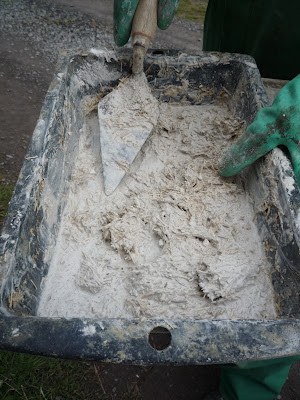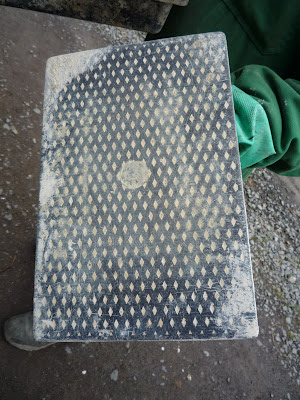The pedal-powered Merry-go-round at Guichen's (Brittany) annual Organic Fair
I just chose a handful from our local area but this will be an on-going theme, which I hope will inspire and make you aware that so many people are already working towards a sustainable future for us all.
Horse-drawn Taxi
We loved this idea for an innovative and stylish Park & Ride system. It was used to carry people and their purchases back and forth from the Organic Salon to the car parks.

Low on fuel, even if a little heavier on organic oats, this 'hippomobile' is symbolic of the shift in organic agriculture back to animal traction and the welcome return of the Heavy Horse to farming.
Also operating before the event is a network for 'covoiturage' (carpool) which allows people going to the Salon to contact others on the same route both to save fuel and also meet others with the same goals and interests.
Pedal-Powered Carousel
This is both fun and educational because you can see that the children on the ride are equally interested in how the merry-go-round works. They are also playing with real physical materials, in this case sand rather than a virtual scenario in CGI!
As these are probably repeat customers, it's a great idea that every year the theme of the roundabout changes. Last year it was Sue's favourite with another great hands-on natural play environment - straw and papier maché poultry.
Manual Savoir-Faire
Another great idea for a sustainable future, a group of dedicated people, who pass on their skills in hand tools and workshop practice to the next generation of builders and craftsmen (and women).
A great message too on the group's van!
"Choose a job you love, and you will never have to work a day in your life."
Confucius 551-479 BC
Raw Organic Milk at the Press of a Button
The milk in this vending machine is straight from the morning's milking so you can't get much fresher than that. Comments on my Youtube channel have suggested that a cow, a three-legged stool and a tray of glasses would be even simpler but on a pavement in a neat little seaside town I think you'd be pushing it!
Another great innovation for this year in Normandie is the production of the first ever AOC (Appellation d'origine contrôlée) Camembert made exclusively from the raw organic milk of the heritage breed; la Vache Normande. This breed, reputed to have been brought to the Normandie coast by the Vikings, is a gentle and beautiful creature, which was completely decimated in the World Wars and brought to the verge of extinction. Now experiencing a welcome comeback mostly through the efforts of organic farmers, we see more and more of them in the fields around our area. See our blog on raw milk and A2 type cows here
Aaaaaaawwww!
Gold, silver or Galléco?
A local currency, which can be exchanged for Euros and used to buy environmentally and ethically responsible local goods. An interesting concept which takes money out of the hands of the too- Big-too-Fail and too-Big-to-Bail.
An Alternative Shopping and Social Centre
Fed up of all the rubbish in the shops at the mall? Well Guichen's new (under construction) straw bale shopping centre is taking the idea literally.
One of its first shops will be stocked with all the stuff from the Dump, which can be repurposed and reused by others.
Where we lived in Warwickshire before we came to France, our local Dump financed itself from its own shop containing all the useful stuff removed from its skips. Bad news for all us scavengers but it's good news for the Environment!
Hoping you have found these ideas inspiring, I'll leave you with our film showing some of them in action.
Thanks for dropping by and please feel free to share this article, comment, ask questions and if you'd like to be assured of getting the next post, then sign up to follow this blog.
All the best, Andy
© Andy Colley 2014
Thanks for dropping by and please feel free to share this article, comment, ask questions and if you'd like to be assured of getting the next post, then sign up to follow this blog.
All the best, Andy
© Andy Colley 2014














































